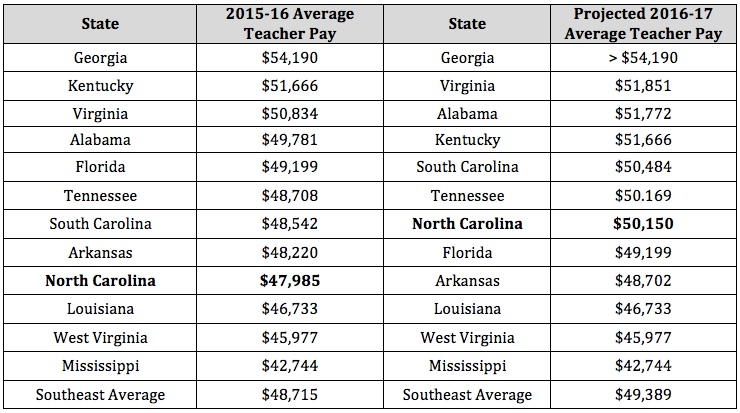Each week, the Forum publishes a newsletter called The Friday Report. The Friday Report provides a weekly update on education issues in the state by culling together news coverage on top education stories. Until this week, my role in The Friday Report has been to help copy edit and prepare the newsletter for distribution. This past week, however, I got my own piece on teacher pay published and shared with over 5,000 subscribers.
As the General Assembly was set to finish the short session, they published the details of their compromise budget last Monday. Included in the budget was a 4.7% average raise for teachers. I was asked to try to project how this raise would impact North Carolina’s place in teacher salary rankings for the Southeast.
The National Education Association publishes an annual ranking of average teacher pay in every state and region. In 2015-16, North Carolina ranked ninth (out of 12) in the Southeast and 41st in the nation. By comparison, in 2003-04, we ranked 22nd in the nation.
Being able to claim a certain spot for teacher pay is not just a matter of pride, it also impacts teacher turnover and our ability to retain and recruit teachers. Other states have been heavily recruiting in North Carolina the past few years, going so far as holding job fairs for out-of-state teaching jobs in North Carolina cities, and using higher average salary as a recruiting tool.
Every time the General Assembly raises teacher pay, they estimate the new average salary and a debate ensues over how the raise will position North Carolina in the rankings. But predicting the rankings can be a bit like aiming at a moving target, because just as North Carolina’s legislators are reviewing our teacher pay scale, legislators and district leaders in other states are doing the same.
Legislative leaders learned this the hard way in 2014 when they passed a 7% pay increase and predicted North Carolina’s average teacher pay would increase from 46th to 32nd in national rankings. This prediction held all other teacher pay in the nation constant from one year to the next. But in fact, due to adjustments to teacher pay made by other states, we only achieved a rank of 42nd, moving up four spots instead of the predicted 14 places.
In order to complete my analysis and project where the North Carolina’s 4.5% raise will position the state, I started by searching for information on other southeastern states’ budget processes and tried to determine if states were increasing education funding or teacher pay. I used news articles, budget bills, and analysis from state education and policy organizations to determine what action was being taken by other states. Using this information, I was able to estimate other states’ changes to teacher pay and generate a more accurate projection for North Carolina’s teacher pay ranking.
Here are the results of my analysis. North Carolina will likely move up two places in the rankings for 2016-17, landing comfortably in the middle of the pack for average teacher pay in the Southeast.
The most challenging part of this project was calculating South Carolina’s pay increase. Their legislature passed what amounted to a 4% increase through increases to two different pay mechanisms. I ended up calling their Education Oversight Committee to understand how the two increases would actually function together. Getting South Carolina’s estimate correct was important because it was so close to North Carolina’s and impacted whether North Carolina ended up sixth or seventh in the rankings.
I was nervous getting on the phone, but the EOC’s executive director was very friendly, and continued the trend I’ve found so far doing various education-based research projects – that people want to help and share information as much as they are able to. I’m sure if I stay in the field long enough, I’ll run into examples where this sense of collaboration and congeniality is not the case, but for now, it makes my work that much more interesting and exciting.


